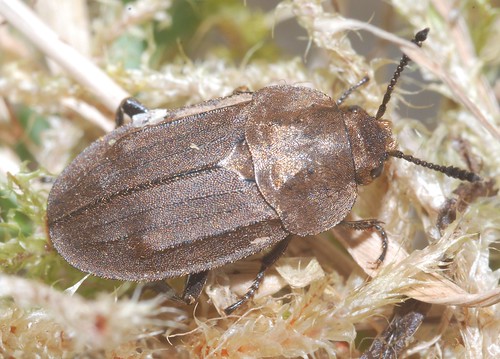This is just to give you something to look at... and to further convince you that we've forgotten all about fossils and are looking at shiny things instead. (Actually, that's not true at all - we're working on all sorts of fossily things at the same time, and there are a couple more papers accepted in the past week; we'll certainly be writing something about them when they're ready.)
This here is one of those things you are only ever likely to see once in your life. And that's only if you're looking, and lucky. It hasn't been seen in Powys for the past 50 years, and is one of those beetles that you just can't imagine being overlooked: it's about a centimetre long, and the golden scales are rather good at catching the sunlight.
It's one of the burying beetles, a delightful carrion-feeding group that are fond of decaying animal remains. In fact, they're so fond of them that they're used in forensics to establish how long a victim has lain undiscovered... Some species have the redeeming feature of burying some tasty morsel with their eggs, and adding themselves (both parents) into the cache in order to take care of the little ones. Rather sweet, really. This one probably doesn't bother, though.
If the food is infested by maggots (as it commonly is), those species with some parental scruples tend to abandon the feast and leave it to the flies. The group that this delightful chap belongs to, though, will apparently just eat the maggots instead. It's amazing behaviour for; just goes to show that one should never judge a book by it's cover...
All that said, it appears that Aclypea opaca is rather different. It's also known as the Beet Burying Beetle, for the simple reason that it's fond of beets and turnips. Rather oddly, and in direct contrast to its cousins, this species is vegetarian. The details of its lifestyle, though, remain somewhat obscure, because it's also rather rare. It's listed as Notable A, and is believed to occur in fewer than 30 ten-kilometre squares across the country. So, when it turns up in deep moss beneath gorse and nettles, in an overgrazed sheepy hillside without a turnip in sight... you just have to wonder what on earth it's doing there.
If we hadn't been looking for those thousand species (see previous post), I'd never have seen it. And that really would have been a shame.
Thursday, 25 April 2013
More Welsh Gold
Subscribe to:
Post Comments (Atom)


I always learn something new when I read your blog.
ReplyDeleteAww, thank you - that's the idea, after all. Actually, I normally learn something new when writing it as well...
ReplyDelete(It's so good to be in a country where we can reply to comments at last...)